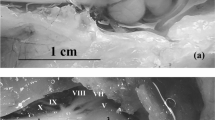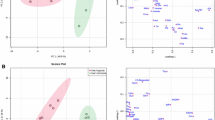Abstract
In this review, causes of tremendous differences in respiration and oxidative metabolism between the homoiothermal and poikilothermal vertebrates are discussed. Tissues of the latter contain no lower, and sometimes even higher amount of mitochondria with the powerful potential of oxidative enzymes, as compared with the homoiothermal vertebrates; only 3–4% of this potential are realized due to a low rate of oxygen transport because of peculiarities of the cardiovascular system of the lower vertebrates. Limitation of the ATP synthesis provided a specific structure of plasma membranes with the much lower amount of channels for the passive ion leak as compared with the mammalian plasma membranes. Examples are presented of the homoiothermal animal cells (the frog olfactory receptor cell) that contact environment without participation of the blood circulation system and have the energy metabolism level comparable with that of mammalian cells. Examples of energetic aromorphosis are tunas with heat exchangers in several organs and with a powerful system of oxygen delivery to cells; owing to this, intensity of their oxidative metabolism could reach that of the higher terrestrial vertebrates. The closing part of this paper describes the molecular mechanisms that allow some representatives of reptiles, amphibians, and fish to survive long periods of hypoxia and anoxia.
Similar content being viewed by others
References
Savina, M.V., Mekhanizm adaptatsii tkanevogo dykhaniya v evolyutsii pozvonochnykh (Mechanism of Tissue Respiration in Evolution of Vertebrates), St. Petersburg, 1992.
Bennett, A.F., Activity Metabolism of the Lower Vertebrates, Ann. Rev. Physiol., 1978, vol. 40, pp. 447–469.
Hochachka, P.W., Defence Strategies against Hypoxia and Hypothermia, Science, 1986, vol. 231, pp. 234–241.
Hulbert, A.J. and Else, P.L., Comparison of the “Mammal Machine” and the “Reptile Machine”: Energy Use Thyroid Activity, Am. J. Physiol., 1981, vol. 241, pp. R350–R356.
Else, P.L. and Hulbert, A.J., Evolution of Mammalian Endothermic Metabolism: “Leaky” Membranes as a Source of Heat, Am. J. Physiol., 1987, vol. 253, pp. R1–R7.
Hochachka, P.W., Metabolic-, Channel- and Pump-Coupled Functions: Constraints and Compromises of Coadaptation, Can. J. Zool., 1988, vol. 66, pp. 1015–1027.
Doll, C.J., Hochachka, P.W., and Reiner, P.B., Reduced Ionic Conductance in Turtle Brain, Am. J. Physiol., 1993, vol. 265, pp. R923–R928.
Doll, C.J., Hochachka, P.W., and Hand, S.C., A Microcalorimetric Study of Turtle Cortical Slices: Insights into Brain Metabolic Depression, J. Exp. Biol., 1994, vol. 191, pp. 141–153.
Edwards, R., Lutz, P.L., and Baden, D., Relationship between Energy Expenditure and Ion Channel Function in the Rat and Turtle Brain, Am. J. Physiol., 1989, vol. 225, pp. R1345–R1359.
Hulbert, A.J., Else, P.L., Manolis, S.C., and Brand, M.D., Proton Leak in Hepatocyte and Liver Mitochondria from Archosaurs (Crocodiles) and Allometric Relationships for Ectotherms, J. Comp. Physiol., 2002, vol. 172, pp. 387–397.
Else, P.L. and Hulbert, A.J., Evolution of Mammalian Endothermic Metabolism: “Leaky” Membranes as a Source of Heat, Am. J. Physiol., 1987, vol. 253, pp. R1–R7.
Stefani, E. and Chiarandini, D.J., Ionic Channels in Skeletal Muscle, Ann. Rev. Physiol., 1982, vol. 44, pp. 357–372.
Lie, H.R., A Quantitative Identification of the Muscle Fiber Types in the Body Muscles of Lampetra fluviatilis and Their Relation to Blood Capillaries, Cell Tiss. Res., 1974, vol. 154, pp. 109–119.
Eisenberg, B.R., Kuda, A.M., and Peter, J.B., Stereological Analysis of Mammalian Skeletal Muscle. 1. Soleus Muscle of Adult Guinea Pig, J. Cell Biol., 1974, vol. 60, no. 3, pp. 732–754.
Nag, A.C., Ultrastructure and Adenosine Triphosphatase Activity of Red and White Muscle Fibers of the Caudal Region of a Fish, Salmo gairdneri, J. Cell Biol., 1972, vol. 55, pp. 42–57.
Kryvi, H., Ultractructure of the Different Fibre Types in Axial Muscle of the Sharks Etmopterus spinax and Galeus melastomus, Cell Tiss. Res., 1977, vol. 184, pp. 287–300.
Hulbert, W.G., Guppy, M., Murphy, B., and Hochachka, P.W., Metabolic Sources of Heat and Power in Tuna Muscle. 1. Muscle Fine Structure, J. Exp. Biol., 1979, vol. 82, pp. 289–301.
Johnston, I.A. and Maitland, B., Temperature Acclimation in Crucian Carp: Morphometric Analysis of Muscle Fibre Ultrastructure, J. Fish Biol., 1980, vol. 17, pp. 113–125.
Kryvi, H., Flood, P.R., and Gulyaev, D., The Ultrastructure and Vascular Supply of the Different Fibre Types in the Axial Muscle of the Sturgeon Acipenser stellatus, Cell Tissue Res., 1980, vol. 212, pp. 117–126.
Johnston, I.A. and Moon, Th.W., Endurance Exercise Training in the Fast and Slow Muscles of a Teleost Fish (Pollachus virens), J. Comp. Physiol., 1980, vol. 135, pp. 147–156.
Totland, G.K., Kryvi, H., Bone, Q., and Flood, P.R., Vascularization of the Lateral Muscle of Some Elasmobranchiomorph Fishes, J. Fish. Biol., 1981, vol. 18, pp. 223–234.
Egginton, S. and Johnston, I.A., A Morphometric Analysis of Regional Differences in Myotomal Muscle Ultrastructure in the Juvenile Eel (Anguilla anguilla L.), Cell Tiss. Res., 1982, vol. 227, pp. 179–199.
Johnston, I.A., Quantitative Analyses of Ultrastructure and Vascularization of the Slow Muscle Fibres of the Anchovy, Tissue and Cell., 1982, vol. 14, no. 2, pp. 319–328.
Johnston, I.A. and Bernard, L.M., Ultrastructure and Metabolism of Skeletal Muscle Fibres in the Tench: Effects of Long Term Acclimation to Hypoxia, Cell Tiss. Res., 1982, vol. 227, pp. 179–199.
Hoppeler, H., Mathieu, O., Krauer, R., Claassen, H., Armstrong, R.B., and Weibel, E.R., Design of the Mammalian Respiratory System. 6. Distribution of Mitochondria and Capillaries in Various Muscles, Resp. Physiol., 1981, vol. 44, pp. 87–111.
Hochachka, P.W., Guppy, M., Guderley, H.E., Storey, K.B., and Hulbert, W.C., Metabolic Biochemistry of Water- vs Air-Breathing Fishes: Muscle Enzymes and Ultrastructure, Can. J. Zool., 1978, vol. 56, pp. 736–750.
Johnston, I.A. Structure and Function of Fish Muscles, Symp. Zool. Soc. (London), 1981, vol. 48, pp. 71–113.
Johnston, I.A., Capillarization, Oxygen Diffusion Distances and Mitochondrial Content of Carp Muscles Following Acclimation to Summer and Winter Temperature, Cell Tiss. Res., 1982, vol. 222, pp. 325–337.
Coulson, R.A. and Hernander, Th., Alligator Metabolism Studies on Chemical Reactions in vivo, Comp. Biochem. Physiol., 1983, vol. 74B, pp. 15–36.
Nakazawa, T. and Nunokawa, T., Energy Transduction and Adenine Nucleotides in Mitochondria from Rat Liver after Hypoxic Perfusion, J. Biochem., 1977, vol. 82, pp. 1575–1583.
Bronshtein, A.A., Obonyatel’nye retseptory pozvonochnykh (Olfactory Receptors of Vertebrates), Leningrad, 1977.
Rudenko, Ya.N., Kinetics of Metabolic Activity of the Olfactory Lining from the Common Frog (Rana temporaria) under Effect of Odorants, Candidate Sci. Dissertation, St. Petersburg, 2007.
Graham, J.B., Heat Exchange in the Yellowfin Tuna and Skipjack Tuna and Adaptive Signification of Elevated Temperatures in Scombrid Fishes, U.S. Fish Bull., 1975, vol. 73, pp. 219–229.
Stevens, E. and Dizon, A.E., Energetics of Locomotion in Warm-Bodied Fish, Ann. Rev. Physiol., 1982, vol. 44, pp. 121–131.
Randall, D.J., Gas Exchange in Fish, Fish Physiology, Hoar, W.S. and Randall, D.J., Eds., New York: London: Acad., 1970, vol. 4, pp. 253–292.
Poupa, O., Lindstrom, L., Mareska, A., and Tota, B., Cardiac Growth, Myoglobin, Proteins and DNA in Developing Tuna (Thunnus thynnis thynnis L.), Comp. Biochem. Physiol., 1981, vol. 70, pp. 217–222.
Laurs, R.M., Ulevitch, R., and Morrison, D.C., Estimates of Blood Volume in the Albacore Tuna, The Physiological Ecology of Tunas, Sharp, G.D. and Dizon, A.E., Eds., N.Y.; S.F.; L.; Acad., 1978, pp. 135–140.
Klawe, W.L. and Barrett, J., Haemoglobin Content of the Blood of Six Species of Scombroid Fishes, Nature, 1963, vol. 198, p. 96.
Carey, F.G. and Teal, J.M., Mako and Porbeagle: Warm-Bodied Sharks, Comp. Biochem. Physiol., 1969, vol. 28, pp. 199–204.
Lutz, P.L. and Nilsson, G.E., Contrasting Strategies for Anoxic Brain Survival-Glycolysis Up or Down, J. Exp. Biol., 1997, vol. 200, pp. 411–419.
Jackson, D.C., Hibernation without Oxygen: Physiological Adaptations of the Painted Turtle, J. Physiol., 2002, vol. 543, pp. 731–737.
Clark, V.M. and Miller, A.T., Studies on Anaerobic Metabolism in the Fresh-Water Turtle (Pseudemis scripta elegans), Comp. Biochem. Physiol., 1973, vol. 44A, pp. 55–62.
Daw, J.Ch., Wenger, D.P., and Berne, R.M., Relationship between Cardiac Glycogen and Tolerance to Anoxia in the Western Painted Turtle, Chrysemis picta bellii, Comp. Biochem. Physiol., 1967, vol. 22, pp. 69–73.
Bickler, Ph.E. and Buck, L.T., Hypoxia Tolerance in Reptiles, Amphibians and Fishes: Life with Variable Oxygen Availability, Annu. Rev. Physiol., 2007, vol. 69, pp. 145–170.
Bickler, Ph.E., Donohoe, P.H., and Buck, L.T., Molecular Adaptations for Survival during Anoxia: Lessons from Lower Vertebrates, Neuroscientist, 2002, vol. 8,no. 3, pp. 234–242.
Hochachka, P.W., Buck, L.T., Doll, C.J., and Land, S.C., Unifying Theory of Hypoxia Tolerance: Molecular/Metabolic Defence and Rescue Mechanisms for Survival Oxygen Lack, Proc. Nat. Acad. Sci. USA, 1996, vol. 93, pp. 9493–9498.
Kelly, D.A. and Storey, K.B., Organ-Specific Control of Glycolysis in Anoxic Turtles, Am. J. Physiol., 1988, vol. 225, pp. R774–R779.
Storey, K.B., Metabolic Adaptation Supporting Anoxia Tolerance in Reptiles: Recent Advances, Comp. Biochem. Physiol., 1996, vol. 113B,no. 1, pp. 23–35.
Bickler, Ph.E. and Buck, L.T., Adaptations of Vertebrate Neurons to Hypoxia and Anoxia: Maintaining Critical Ca2+ Concentrations, J. Exp. Biol., 1998, vol. 201, pp. 1141–1152.
Buck, L.T. and Hochachka, P.W., Anoxic Suppression of Na+, K+, ATPase and Constant Membrane Potential in Hepatocytes; Support for Channel Arrest, Am J. Physiol., 1993, vol. 265, pp. R1020–R1025.
Shin, D.S.-H., Wilkie, M.P., Pamenter, M.E., and Buck, L., Calcium and Protein Phosphatase 1/2A Attenuate N-Methyl-D-Aspartate Receptor Activity in the Anoxic Turtle Cortex, Comp. Biochem. Physiol., 2005, vol. 142A, pp. 50–57.
Lutz, P.L. and Nilsson, G.E., Vertebrate Brains at the Pilot Light, Respir. Physiol. Neurobiol., 2004, vol. 141, pp. 285–196.
Hochachka, P.W. and Lutz, P.L., Mechanism, Origin, and Evolution of Anoxia Tolerance in Animals, Comp. Biochem. Physiol., 2001, vol. 130B, pp. 435–459.
Boutilier, R.G., Donohoe, P.H., Tattersall, G.J., and West, T.G., Hypometabolic Homeostasis in Overwintering Aquatic Amphibians, J. Exp. Biol., vol. 200, pp. 387–400.
Shoubridge, E.A., and Hochachka, P.W., Ethanol: Novel End Product of Vertebrate Anaerobic Metabolism, Science, 1980, vol. 209, pp. 308–309.
Johansson, D. and Nilsson, G.E., Roles of Energy Status, K+-ATP Channels and Channels Arrest in Fish Brain K+ Gradient Dissipation during Anoxia, J. Exp. Biol., 1995, vol. 198, pp. 2575–2580.
Nilsson, G.E., Surviving Anoxia with the Brain Turned On, News Physiol. Sci., 2001, vol. 16, pp. 217–221.
Boutilier, R.G., Mechanism of Metabolic Defence Against Hypoxia in Hibernating Frogs, Resp. Physiol., 2001, vol. 128, pp. 365–377.
Knickerbocker, D.L. and Lutz, P.L., Slow ATP Loss and the Defence of Ion Homeostasis in the Anoxic Frog Brain, J. Exp. Biol., 2001, vol. 204, pp. 3547–3551.
St-Pierre, J. and Boutilier, R.G., Aerobic Capacity of Frog Skeletal Muscle during Hibernation, Physiol. Biochem. Zool., 2001, vol. 74, pp. 390–397.
Donohoe, P.H., West, T.G., Boutilier, R.G., Factors Affecting Membrane Permeability and Ionic Homeostasis in the Cold-Submerged Frogs, J. Exp. Biol., 2000, vol. 203, pp. 405–414.
St-Pierre, J., Brand, M.D., and Boutilier, R.G., The Effect of Metabolic Depression on Proton Leak Rate in Mitochondria from Hibernating Frogs, J. Exp. Biol., 2000, vol. 203, pp. 1469–1476.
Author information
Authors and Affiliations
Additional information
Original Russian Text © M. V. Savina, L. V. Emelyanova, I. V. Brailovskaya, 2009, published in Zhurnal Evolyutsionnoi Biokhimii i Fiziologii, 2009, Vol. 45, No. 2, pp. 157–168.
Rights and permissions
About this article
Cite this article
Savina, M.V., Emelyanova, L.V. & Brailovskaya, I.V. Bioenergetics of the lower vertebrates. Molecular mechanisms of adaptations to anoxia and hypoxia. J Evol Biochem Phys 45, 197–210 (2009). https://doi.org/10.1134/S0022093009020029
Received:
Published:
Issue Date:
DOI: https://doi.org/10.1134/S0022093009020029




